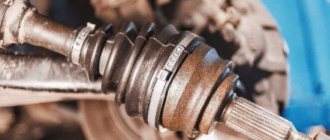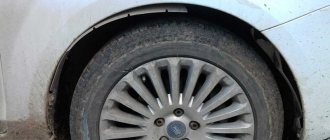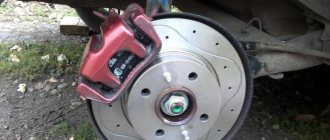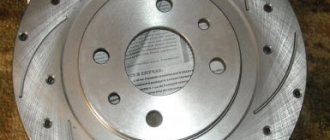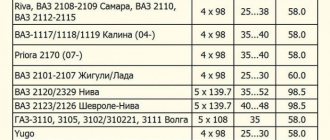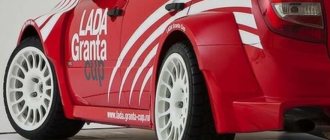The braking system of modern cars consists of a rotating disc and stationary brake pads, which apply pressure to the disc from both sides to slow down the movement. The geometry of the moving element of the brakes must be almost ideal. Otherwise, braking efficiency is significantly reduced.
The curvature of the surface of the brake elements poses a danger to the life and health of motorists, so their condition must be regularly monitored. If functionality is impaired, it must be replaced.
But often service stations that have the appropriate equipment advise a cheaper way out of the situation - regrooving the brake discs. The benefits of workshops are clear, but is it worth the trouble for the driver?
When to change
As a rule, brake discs last for two or three pad changes, but this is ideal. During intensive driving, the wear on the discs can become enormous and there will not be enough for the next pad replacement. Even if you drive in a quiet mode, brake discs are easy to “kill” .
For example, after heavy braking you find yourself in a puddle. Even a special shield under the wheel arch will not save you from water - it only protects from dirt. Because Since most brake discs are made of cast iron, they are subject to sudden temperature changes when water from a puddle cools them sharply. This leads to warping of the working surfaces, which will affect the steering wheel and brake pedal of the car. And it manifests itself when you begin to brake smoothly, and a slight tremor is felt on the steering wheel and brake pedal.
Cast iron is the most common material for brake discs. But with a sharp change in temperature, it changes its hardness, volume and internal structure. There are more durable analogs - ceramic, composite, which provide better stability and braking, but are more expensive.
Brake discs - to sharpen or not?
Despite the fact that grooving brake discs has become quite widespread in Russia, it is best not to do it. Why does this operation result in wasted money? The brake discs of a car are the same consumables as engine oil, various types of filters and brake pads. The only difference between them is that the service life of these braking system parts is much longer. On average, one set of discs can last as long as two pairs of brake pads, and sometimes even three. Although the critical mileage level can rarely reach 100 thousand kilometers, most often it stops at around 60-80 thousand. Operation of brake discs. In an ideal scenario, the brake discs on the car can perform their function without problems, and can become thinner until their thickness is reduced to a certain value specified by the manufacturer. The mirror of the working surface, in this situation, still remains smooth. But such trouble-free operation may not always be possible. On one car, the braking discs may be bent; when braking, the pedal will noticeably push into your foot, and the car will slow down with noticeable jerks. In another embodiment, uneven wear of the disk surface may be observed due to misalignment of the cylinder supports or souring of the guides.
In both the first and second cases, there is a decrease in the efficiency of the brake system, and the car owner is faced with a choice between replacing the brake discs along with the pads, or trying to revive the old parts by turning them.
Reasons why it is better not to make a groove. The presence of runout in the brake pedal, as well as the steering wheel when braking, almost with a 100% guarantee means replacing the brake discs. Warping of brake discs does not happen without reason - for this to happen there must be severe overheating or a large temperature difference. Although good quality brake discs rarely bend even in such cases. If this does happen, it makes sense to turn to products from other manufacturers rather than attempt to machine parts of questionable quality. After the groove is completed, the disk runout will be eliminated, but not for long, since the disk will warp again after some time.
Another point why it makes no sense to grind discs is their rather short service life. Each manufacturer clearly stipulates the degree of wear, which is not recommended to be exceeded; it is rarely more than 1 mm in each direction. When the thickness of the disk is reduced by 2 mm on each side, its place is no longer on a lathe for grooving, but in scrap ferrous metals. You can get acquainted with the values of the maximum permissible wear by looking at the end of the disk itself, or the technical documentation for the machine. Even with a minimal degree of curvature, another 0.2 to 0.4 mm will be removed from it. Taking into account that the disk has already had a certain degree of wear, the client receives a part close to the time of disposal.
Why do manufacturers recommend replacing them with such little wear? The fact is that cast iron is negatively affected by sudden changes in temperature; it requires a good degree of cooling, otherwise the properties of the metal itself change. When the brake discs wear out, the thickness is compensated with the help of calipers, the pistons come out more and more, which leads to a decrease in the precision of the braking mechanisms and misalignment of the pads.
Bottom line. Regrooving old brake discs can only be justified under certain circumstances. Regrooving old brake discs can only be justified under certain circumstances. For example, purchasing new components is very expensive or difficult to find. Grooving is also practiced by ordinary resellers, since after trimming and updating the chamfers of the disks, they can be presented as almost new, which will make it possible to increase the price of the car being sold.
How to determine when to change brake discs
When replacing pads, you need to carefully inspect the surface of the disc for warping and cracks.
Cracks and other flaws can be easily identified visually. To check warping, you need to run your finger over the surface of the disk - it should be perfectly smooth. If deep waves are noticeable, then we change or sharpen them. If there is slight warping, then urgent replacement is not required. We also pay attention to the residual thickness - it should be at least 50%. After this we decide on a replacement.
There is another way to determine whether brake discs need to be replaced. Typically, beating responds with vibrations on the steering wheel, brake pedal and body. If you feel vibration when braking, then release the brake pedal for a while - if the vibration stops, then you need to change the discs or sharpen them.
Why do they grind discs?
When the discs are deformed, the braking distance increases to 20 meters, so the condition of these elements requires constant attention. It is especially important to do this on modern cars with ABS and PBS systems, since here the safety of the driver and passengers depends on the coordinated actions of all elements of the braking system. This will be entirely determined by the driving skill of the person driving the car on a slippery road.
If the surface of the discs is rough and uneven, then even replacing the brake pads will not give the desired result until they are ground in.
If vibrations occur in the vehicle or the brake pedal, the brake system must be checked immediately.
In case of disc geometry violation, many service stations recommend regrooving. Most manufacturers recommend replacing these elements of the brake system only after 80 thousand kilometers, so repairing these parts can be considered justified.
The moving parts of the brakes are expensive. On the other hand, they have an increased service life compared to static pads. Recently, some car workshops have begun to purchase equipment for turning brake discs. This procedure is much cheaper than a new purchase, so the service is in demand.
Is it worth grinding
If the brake disc of a car has wear in the form of irregularities on the surface, then they can be sharpened. The main thing is to determine the wear so that the thickness allows it to be sharpened. Too thin cannot be sharpened; they will not withstand heat load well, which will result in their destruction. Also, before grooving, they are checked for the degree of corrosion and the amount of runout. The cost of re-grooving is cheaper than the cost of new ones. If the residual depth allows them to be sharpened, then you can save on this operation. It is worth considering that it is necessary to sharpen both brake discs (so as not to shift the balance of the brakes) and then replace the pads with new ones. What is it for? If there was warping, then the friction layer of the pads was also damaged. If you do not change them, they will not fit the entire area. This will reduce the car's braking intensity.
What affects wear?
Each manufacturer prescribes brake disc wear standards. These parameters are obtained based on engine power, vehicle weight and other factors. But it is very difficult to calculate the mileage after which you will need to change the discs. Wear is influenced by various factors that cannot be taken into account.
First of all, it's your driving style. If the car owner prefers to drive more extreme, where sharp accelerations are replaced by equally sharp braking, then the service life of the disc is significantly reduced.
Mechanical factors also affect the service life. The material from which the brake disc is made is important here, as well as the quality of the pads. Often, discs are made from cast iron and its alloys - the material wears out more often than ceramics. The use of low-quality pads (for example, with asbestos) also leads to uneven wear.
Is it possible to do it yourself?
This is not recommended because...
for example, it is impossible to do this on a lathe - the errors during turning will be large and it will not be possible to fix the disk properly. You may get the effect that it was better before the grooving than after it. Therefore, the auto service center performs this operation without removing it and sharpens both discs at the same time. This is the only way to eliminate different groove thicknesses. It is recommended to do this every time you change the pads.
In the service, the groove will cost about 2 thousand rubles without removing and replacing the pads (not included in the price). For example, the cost of original wheels for a car is 2 times higher. In addition, sharpening factory brake discs is better than buying new ones of unknown quality.
How to find out the abrasion thickness?
In order to find out the permissible maximum thickness of the brake disc, you should look at the end of the product. There are two meanings to this part. This is the original thickness, as well as the minimum allowable. The numbers may vary depending on the car and wheel manufacturer. How to determine the degree of wear of brake discs? It is enough to simply measure with a caliper and compare the numbers with acceptable standards. This is how you determine whether the product can still be used or not. The disc should also be changed if it has different thicknesses at different points.
Grooving brake discs without removing them from the car
If you do not remove the brake discs from the car, sharpening them is much easier. But the important point here is that you need to have appropriate equipment, which is not present in all services. In other words, it is unlikely that it will be possible to grind brake discs in a similar scenario “in the garage.”
Grinding of brake discs without removal is carried out as follows:
The car must be secured on a lift and the wheels removed;- Next, access to the disk is freed; to do this, you need to unscrew the caliper (hanging it by the holder to the spring);
- After this, using tools, the approximate curvature of the disk blade is measured to determine how much metal needs to be removed from the part;
- Next, a special engine is attached to studs or fastening points. His task will be to promote the disk. A frame is screwed to the support, which will serve for the movement of the cutters. It is important to note that the cutters must simultaneously grind the planes above and below;
- After this, the actual grooving process begins.
Growing brake discs without removing them from the car does not take much time. It is important to note that two planes are machined. The area adjacent to the hub, since the disk is not removed, remains untouched. This is an important difference from the disc removal method.
Grooving brake discs with removal from the car
This grooving method also requires good equipment and accurate measurements in order for the work to be completed efficiently. Unlike the previous method, here it is necessary to completely remove the brake disc from the car and grind three surfaces, including those adjacent to the hub.
It is important that all three surfaces are machined at the same time with one attachment to the machine, otherwise the parallelism of the planes may be lost if the disk is “turned over”. Accordingly, for such work you need a specialized machine or a reverse cutter, otherwise it will be difficult to get close to the third plane.
